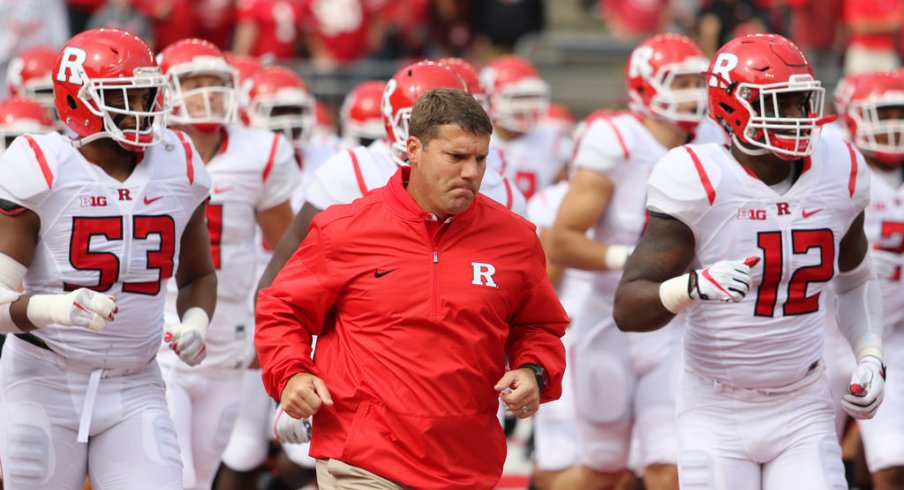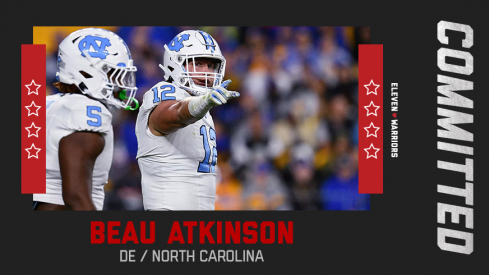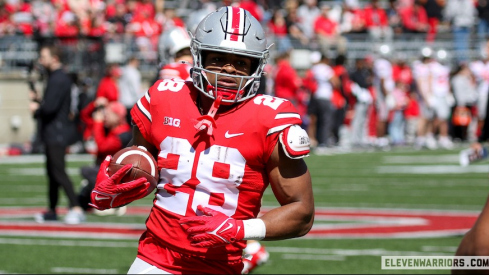There is a mountain of things you can say about Rutgers athletics. Most of them are bad.
The Scarlet Knights have solid men's lacrosse and wrestling programs, their women's soccer team finished above .500 and women's lacrosse team went 8-8. Every other athletic program finished either third-to-last, second-to-last or — you guessed it — last in the Big Ten over the course of the 2016-17 school year.
That includes the football team, led by former Ohio State defensive coordinator and safeties coach Chris Ash. He went 2-10 in his first season as head coach, including a 0-9 mark in conference play. To pile on the team's struggles even more, the Scarlet Knights didn't score a single point against Ohio State, Michigan, Michigan State or Penn State.
That's right: the Buckeyes, Wolverines, Spartans and Nittany Lions outscored Ash's club a combined 224-0. Big Ten Commissioner Jim Delany's push for conference expansion brought Rutgers into the fray ahead of the 2014 academic calendar, and things haven't been great on the field, court or any other athletic avenue since.
Former football coach Kyle Flood's attempted exploitation of an instructor to change one of his best player's grades put a bow on a tenure that drifted south quickly after a victory in the 2014 Quick Lane Bowl to cap an 8-5 season. Player arrests followed, guys left the program and Ash had to start from scratch, which was blatantly apparent last fall.
Ohio State fills its conference obligation and obligation to the Big Ten Network's yearn for East Coast viewers (Hello, New Yorkers!) on the last day of September when it plays Rutgers at High Point Solutions Stadium. Let's take a closer look at the second phase of Ash's rebuilding process.
Offense
Let's get the most egregious hateful language out of the way first: It is hard to find an offense of a Power 5 football team that was worst than Rutgers last season.
The Scarlet Knights scored 102 points during the non-conference, including a 42-13 loss to eventual College Football Playoff participant Washington in Seattle. They scored 86 points the rest of the season.
We already spoke about the four shutouts. But Rutgers only hit double-digits in Big Ten play twice, in losses at Minnesota and against Indiana. The 15.7 points per game were easily the least in the Big Ten and only Connecticut's 14.8 (!) trumped it for Worst Scoring Offense In College Football.
| Head Coach | Chris Ash (2nd season, 2-10 record at Rutgers) |
| 2016 Record | 2-10, last in the Big Ten East Division at 0-9 |
| 2016 Postseason | None |
| Biggest Losses | Three starters on OL, |
| Biggest Returnees | RB Robert Martin, WR Jawuan Harris, |
| Summary | Rutgers was terribly bad in 2016. Can Ash pull some tricks this fall? |
| Matchup | Sept. 30, 2017: Ohio State at Rutgers, kickoff TBA |
The Scarlet Knights had some playmakers at receiver and running back, but their best one (Janarion Grant) went down with a broken ankle in the Big Ten opener against Iowa. Jawuan Harris, a freshman, led the team with 39 catches for 481 yards and three touchdowns.
The biggest problem for Ash was his quarterback play. Chris Laviano's name was atop the depth chart for the majority of seven games before his head coach moved on to Giovanni Rescigno, a sophomore. The two of them barely combined to complete 50 percent of their passes and threw five touchdowns apiece. Ash then tried Tylin Oden and Zach Allen when he had literally nothing else to lose. They completed just two passes on 20 attempts.
Laviano is no longer with the program, transferring to San Diego State. Hayden Rettig, another quarterback, also left for Tennessee Tech. In an effort to ensure some form of positivity in Year 2 (should we call it Year 1?) Ash took major advantage of the graduate transfer rule to enhance his offense. The players he added:
- Former 4-star Louisville quarterback Kyle Bolin;
- Former 3-star Miami (FL) running back Gus Edwards;
- Former 3-star Arkansas receiver Damon Mitchell; and
- Former 4-star Miami (FL) tight end Jerome Washington (traditional transfer)
Bolin lost his job to 2016 Heisman Trophy winner Lamar Jackson and has experienced by far the most success as any other individual in Rutgers quarterback room at the college level. Expect Ash to start him this fall barring anything unforeseen.
Senior Robert Martin led the Scarlet Knights with 625 rushing yards on 121 carries, nearly a 5.2 yards per carry average. A modern miracle considering the complete absence of the passing game, Martin was also inconsistent. He and the other backs in the program must run behind an offensive line that lost three of its main contributors (and 31 of last year's 60 starts) to graduation. Senior guard and two-year starter Dorian Mitchell, as well as left tackle Tariq Cole return, though.
Ash also hired former Minnesota head coach Jerry Kill as his offensive coordinator after Drew Mehringer went to work for Tom Herman at Texas. Kill had to retire from Minnesota due to health concerns resulting from seizures but spent the 2016 season at Kansas State as an associate athletic director.
Ash recruited well by Rutgers standards, bringing in a trio of 4-stars to inch the class to a ninth-place finish in the Big Ten. One of them is receiver Bo Melton, who could see big minutes early in his career if he can prove he can beat a defensive back and bring some sort of explosion to an offense that lacked it. Grant and Harris are also back, a decent stable of weapons for whoever gets the nod at quarterback.
With Kill in charge, Rutgers's offense won't look anything like it did a year ago. Will it be better? Maybe. But it desperately needs more playmakers and depth.
Defense
Any halfway knowledgeable football fan knows that if their team's offense can't stay on the field, the unit on the other side of the ball is going to suffer. Rutgers's offense took whatever prayer a semi-decent defense before injuries had at being successful and threw it out the window when it averaged eight punts a game. Eight. No team in the NCAA punted more than Rutgers in 2017.
The fact the Scarlet Knights managed to finished 97th in total defense allowing *only* 450 yards a game should merit some form of parade or something. The unit was on the field an average of 43 minutes per game.
To make matter worse, its best players couldn't stay off the injury report. Defensive end Quanzell Lambert was lost for the season after only four games. Then linebackers Greg Jones, Najee Clayton, Isaiah Johnson and Andre Hunt combined to miss nearly 40 games. Too often, Ash had to ask his assistants if he simply had enough healthy bodies to run out against Big Ten opponents as the weather grew colder.
Graduation and transfers leave the unit without too many upperclassmen returning to play a part on defense in 2017. With Lambert, another end in Julian Pinnix-Odrick (team-leading 10 tackles for loss) and former All-Big Ten performer Darius Hamilton all gone, there are holes to fill up front.
Ash is a defensive mind, however, as Ohio State fans experienced in the 2014 and 2015 seasons. His young bodies got experience out of necessity last fall, so things should be better this season. Four-star outside linebacker commit Tyshon Fogg has a chance to contribute early due to the departures, though a pair of juniors — Trevor Morris and Deonte Roberts — got better as the season wore on and they took more snaps.
Ash will have options to plug and play at linebacker, a positive considering how little depth he has up front defensively. Blessuan Austin and Isaiah Wharton played well at corner in 2016 and should return to help form a somewhat formidable duo at the position. But once again, Ash will build for 2018 after hopefully inking another solid recruiting class and installing his defensive principles.
If Ohio State struggles against Rutgers, high anxiety would (and should) permeate throughout the fan base. Urban Meyer encouraged Chris Ash to take the job because of the fertile recruiting territory that exists on the East Coast.
Last season, Ash probably wondered whether his old boss was being cruel because of how quickly things turned sour in Piscataway. Rutgers should be better in 2017 — it can't be much worse — but Ash has to get some more capable bodies to establish his program as any form of threat in the Big Ten East. He shouldn't be judged until at least 2018 as he builds his roster essentially from the ground up but Rutgers won't strike too much fear into its opponents this season.


